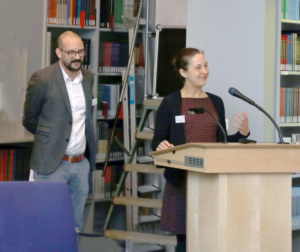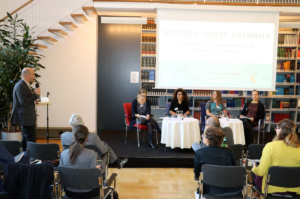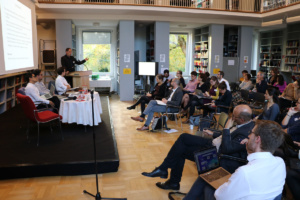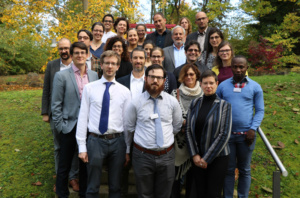Thinking through Uprootedness and Emplacement
> “Borders, Fences, Firewalls: Assessing the Changing Relationship of Territory and Institutions,” Conference at the Max Planck Institute for the Study of Religious and Ethnic Diversity, Department of Ethics, Law and Politics, October 19–20, 2017 | Library Hall at MPI-MMG, Göttingen
A summary by Derek Denman
 “Isn’t Macbeth’s fate a great metaphor for the nation state … so many things, firmly believed ‘earth-bound’ … have become unfixed and uprooted?” Stefan Schlegel’s question in his introductory remarks was as much a frame for the conversation to come as it was a testament to the creativity that motivated the conference. Ayelet Shachar, Director of the Department of Ethics, Law and Politics of the Max Planck Institute for the Study of Religious and Ethnic Diversity; Dana Schmalz, co-organizer and Postdoctoral Research Fellow in the Department; and Stefan Schlegel, co-organizer and also a Postdoctoral Research Fellow, opened the conference with insights into the spirit of inquiry that brought together seventeen panelists and two keynote speakers for a two-day interdisciplinary conversation on territory and institutions.
“Isn’t Macbeth’s fate a great metaphor for the nation state … so many things, firmly believed ‘earth-bound’ … have become unfixed and uprooted?” Stefan Schlegel’s question in his introductory remarks was as much a frame for the conversation to come as it was a testament to the creativity that motivated the conference. Ayelet Shachar, Director of the Department of Ethics, Law and Politics of the Max Planck Institute for the Study of Religious and Ethnic Diversity; Dana Schmalz, co-organizer and Postdoctoral Research Fellow in the Department; and Stefan Schlegel, co-organizer and also a Postdoctoral Research Fellow, opened the conference with insights into the spirit of inquiry that brought together seventeen panelists and two keynote speakers for a two-day interdisciplinary conversation on territory and institutions.
The conference arose from “a weakness for big ideas” and the desire to engage in thinking that was truly transformative, explained Ayelet Shachar in her opening remarks. The conference was inspired by the seeming contradiction of the proliferation of new boundaries—state, private, and virtual—at a moment when many proclaim the triumph of absolute mobility. How could these trajectories be reconciled? What are we to make of the “mobility” of the refugee, when that mobility often refers to displacement? These questions require the time and resources to formulate the right questions and speak across disciplines in pursuit of answers. They bring politics, law, technology, economic globalization, and social inequality into the discussion of territory and institutions. Ayelet Shachar credited the Max Planck Institute for the Study of Religious and Ethnic Diversity with the trust and freedom to nourish thorough and vigorous research in pursuit of nuanced answers to such complex questions.
Stefan Schlegel and Dana Schmalz expanded on the metaphor provided by Shakespeare’s Macbeth. Reflecting on the prophecy that “his kingship was secure until the great Birnam wood shall come against him,” Stefan Schlegel suggested the nation-state today is in a condition similar to Macbeth’s, unable to tell what is secured and what might begin to shift unexpectedly. Dana Schmalz also drew upon Macbeth to offer a cautionary note for studying territory and mobility. For Macbeth, the trees appeared to be moving, defying all he knew to be possible and natural. Yet when all was revealed, the trees were only the most familiar of enemies. Might the study of deterritorialized institutions encounter the same dilemma, finding seemingly new political phenomena are in fact different manifestations of familiar power relations? With that cautionary note in mind, the conversation was now officially underway.
Traditional Legal Concepts of Territoriality under Pressure
In the opening panel, Catherine Brölmann, Associate Professor of International Law at Universiteit van Amsterdam, examined current legal understandings of territory and framed the stakes of the conference in her presentation, “Territory in Late-Modern International Law.” Applying an “immanent perspective” to the study of international law, she took us inside the head of an international lawyer in order to unravel the discourse and practice of international law. Her conclusions highlighted the limitations of the predominant approach to territory in international law and offered new horizons for the exploration of the concept.
Expanding on the role of territory in international law, Gail Lythgoe’s “Toward a New Theory of Territorial in International Law” suggested that, in addition to the state, there are “more heterogeneous modalities of territory.” As a foray into this larger field of territoriality, Lythgoe sought to develop the territorial dimensions of international organizations, entities often thought to be uprooted from territory. Her presentation pointed to the alternative ways in which international organizations exert political power related to place, thereby enacting their own unique form of territoriality. During the discussion, Lythgoe suggested that such an expanded notion of territoriality was also necessary to recover a space for those actors in global politics erased by colonial organization of space.
Finally, Oran Doyle’s ambitious paper, “The Silent Constitution of Territory” examined the definition of territory within constitutions. Doyle noted the general absence of references to territory in constitutions, though in some cases he found oblique references to the process of delineating territory, and, in rare cases, explicit attempts to define the boundary lines of a state. His presentation sparked a number of questions focused on the methodological difficulties of studying territory in constitutions.
Thinking through the The Arc of Protection
Alexander Aleinikoff, University Professor and Director of the Zolberg Institute on Migration and Mobility at the New School, delivered a keynote address that was equal parts pragmatic political engagement and inspiring moral vision. Drawing on work from his current book project, provisionally titled The Arc of Protection, Aleinikoff identified the fundamental contradictions of the international refugee protection regime, focusing on its denial of agency to refugees and the bargain it strikes with the existing order of state sovereignty. In particular, a “new liberal consensus,” while partially responsive to the needs of refugees, imposes a “second exile” in which refugees are excluded to a substantial degree from the society, economy, and political life of their host country.
Seeking to go beyond the new liberal consensus, Aleinikoff outlined principles of protection: safety, emplacement, solutions, mobility, and voice. These principles would strengthen the rights of refugees and allow for movement necessary to avoid a second exile. He offered an array of procedures and actions at different scales to realize these principles, including political organization of refugees as a constituent body able to exercise agency and voice on their own behalf.
Jürgen Bast framed the discussion with a response to the keynote, which focused on the omission of human rights in principles of protection. Rather than emplacement, why not speak of economic, social, and cultural rights; rather than mobility, why not speak to a human right to free movement, and why not formulate human rights-based membership? Discussion from the audience further examined the proposed principles of protection, bringing the ideas of safety and emplacement under closer scrutiny. Alexander Aleinikoff admitted that emplacement had been the most difficult principle to formulate, but its inclusion provided an important sense of place in a protection regime. He responded to Jürgen Bast’s challenges about human rights by suggesting that he wanted to go beyond rights and offer political solutions for the paradox of the refugee problem and that emplacement is both a legal and political project.
Mobility and Marginalization
 The panel “Mobility and Marginalization” considered the multiple processes, levels, and scales of inequality. In “Global Social Inequality, Nationality, and Territorial Access: The Case of the Global Visa Regime,” Lena Laube observed a bifurcation in the global distribution of mobility rights. Visas play a formative role in the “global mobility divide,” providing a legal avenue for discrimination against members of a national community. An examination of the visa freedom index revealed that it aligned closely with a map of GDP per capita, suggesting a strong correlation globally. Laube identified the secondary effects of visa policies which can influence the likelihood of migration and attempts to seek asylum.
The panel “Mobility and Marginalization” considered the multiple processes, levels, and scales of inequality. In “Global Social Inequality, Nationality, and Territorial Access: The Case of the Global Visa Regime,” Lena Laube observed a bifurcation in the global distribution of mobility rights. Visas play a formative role in the “global mobility divide,” providing a legal avenue for discrimination against members of a national community. An examination of the visa freedom index revealed that it aligned closely with a map of GDP per capita, suggesting a strong correlation globally. Laube identified the secondary effects of visa policies which can influence the likelihood of migration and attempts to seek asylum.
Valentina Aronica’s discussion of migratory governance in “Italy, the Mediterranean as Political Space, and Implications for Maritime Migration Policy” argued that Italy’s alteration of its policies toward refugees crossing the Mediterranean displayed competing conceptions of sovereignty—an understanding of sovereignty defined by security concerns, and a “humanitarian sovereignty” enacted in rescue operations.
Asking the question “Is Immigration Detention a New Form of Territorial Border?” Rottem Rosenberg Rubins drew on Gilles Deleuze’s theory of “control societies” to describe the management of populations and the delocalization of borders through the construction of detention centers. Rosenberg Rubins sees this process creating a “spectrum of non-membership” whereby a process of social exclusions steps in where physical exclusion is not permitted.
The discussion with the audience focused on the different forms of power identified in the presentations. Questions directed to Valentina Aronica sought to differentiate between specific state policies, which may be more or less hospitable to refugees, legal claims about state jurisdiction, and the institution of state sovereignty. Engagements with Lena Laube and Rottem Rosenberg Rubins considered their descriptions of complex configurations of power over mobility, asking how they account for these powers that are both global and local.
Technology Transforming Spaces of Mobility
 The panel “Technology Transforming Spaces of Mobility” was united as much by the theme of the body, and the forces of labor and migration working upon it, as it was by an examination of technologies.
The panel “Technology Transforming Spaces of Mobility” was united as much by the theme of the body, and the forces of labor and migration working upon it, as it was by an examination of technologies.
In “The Invisible Border – How Asylum Seekers and Beneficiaries of International Protection are Prevented from Moving Freely in the Schengen Area,” Constantin Hruschka considered the array of technologies applied to the bodies of those moving through the Schengen area, the policies of associated states, and the challenges these create for EU asylum reform.
Turning to the perspective of those left behind by others who migrate, Elizer Jay de los Reyes examined the lives of young people within a labor diaspora in “Red Spit, Broken Backs, and Abstract Pesos: New Mobilities and Youth Imaginations in a Transnationally-Linked Village in the Cordillera Mountains of Northern Phillipines.” De Los Reyes’s ethnographic work approached the way experiences of family are subsumed under economic narratives of a “better life.” De Los Reyes asked, when migrant work is valorized as “global-orientedness” and equated with progress, what message is sent to those who are “left behind?”
Fabio Cristiano took us through the overlap of virtual spaces of play and physical spaces of occupation in “Along the Lines of Occupation: Playing at Diminished Reality in East Jerusalem.” Following the 1949 Armistice Line within Pokémon Go, Cristiano’s dérive explored the lines and voids represented and erased when augmented reality is overlaid on occupied territory.
The conversation between panelists and with the audience brought the significance of mobile labor, virtual spaces, and the specific technologies employed at borders into the conversation about migration and territoriality.
Outlining A Political Theory of Territory
The Friday session commenced with Margaret Moore, Professor in the Political Studies department at Queen’s University, presenting “Territory and Self-Determination,” part of her 2015 book A Political Theory of Territory. Moore started from the premise that territory is a political concept, distinct from material land. Every theory of territory triangulates a relationship between land, people, and the state. Moore’s theory offered a conception of this triangle that is normatively defensible and responsive to global ethical and political concerns. In particular, Moore suggested the territorial system is in need of such a defense if it is to endure the compelling philosophical challenges from cosmopolitan theorists and has to address the numerous practical challenges, including global climate change, inequalities of global capitalism, and failures to respond to refugee flows.
Moore clarified that by providing a defense of territory she does not aim to preserve the existing order of territorial states. Rather, she envisions a theory of territory able to respond to demands for global justice while remaining committed to self-determination. This system of territory embraces international law as its complement. International law and international institutions both arbitrate disputes over self-determination and respond to the “externalities” of particular states.
During the discussion, the audience focused on Moore’s criteria for self-determination. Ayelet Shachar asked how one goes about distinguishing between the cultural identity and political identity of a community. Gail Lythgoe pointed out problematic links between the criteria for the assessment of self-determination and histories of colonialism. Further questions sought to understand the implications for global ecology and responses to climate change enabled by Moore’s theory of territory.
Time and Territoriality
 “Time and Territoriality” shifted the focus from a spatial understanding of territory to the temporal frames and boundaries that define belonging and membership. Opening with a history of the term “deadline,” Elizabeth Cohen provided a thoughtful account of the boundaries in time that restrict movement in “Temporal Boundaries, Political Power, and Free Movement.” Cohen argued that political communities delineate between inside and outside not only by drawing spatial borders but also through the establishment of temporal boundaries. For instance, by overstaying a visa, one’s legal status changes without ever changing geographic location. Cohen noted that the ways these boundaries are drawn have implications for democracy. Temporal boundaries set at a single moment are arbitrary, uncontestable, and therefore, anti-democratic. Temporal boundaries that repeat periodically, such as elections, enable democratic practice.
“Time and Territoriality” shifted the focus from a spatial understanding of territory to the temporal frames and boundaries that define belonging and membership. Opening with a history of the term “deadline,” Elizabeth Cohen provided a thoughtful account of the boundaries in time that restrict movement in “Temporal Boundaries, Political Power, and Free Movement.” Cohen argued that political communities delineate between inside and outside not only by drawing spatial borders but also through the establishment of temporal boundaries. For instance, by overstaying a visa, one’s legal status changes without ever changing geographic location. Cohen noted that the ways these boundaries are drawn have implications for democracy. Temporal boundaries set at a single moment are arbitrary, uncontestable, and therefore, anti-democratic. Temporal boundaries that repeat periodically, such as elections, enable democratic practice.
Andrew Bennett’s “Wilderness as a Fundamental Concept of Law” offered an alternative to the political theology of sovereignty provided by Carl Schmitt. Bennett finds in the biblical concept of “desert-wilderness” a “space-time of sovereign contestation” and a middle space between state of nature and sovereign exception. Rather than the law coming into being through the condition of sovereign exception, Bennett suggests that law is instead founded upon a gradual development from chaos over wilderness to a covenant between God and people. This understanding remains present in a “romanticized account of how sovereign and people journeyed through the wilderness.”
In “The Ontology of a ‘Train to Nowhere’” Sharri Plonski critically examined the HaEmek railway as illustration of competing narratives. The train line would serve an important symbolic function, as a piece of what is deemed “critical infrastructure,” while merely establishing a limited route from the sea to Israel’s border with Jordan. Enabling the faster movement of goods in a space where the movement of people is highly limited, the train exhibits the contradictory condition of mobility.
Globalization and Stratification
Yossi Harpaz’s presentation, “Border Crossing as Social Boundaries: When a Second Passsport Becomes a Status Symbol,” resonated with earlier discussions of global social inequality. Harpaz theorizes “compensatory citizenship,” the acquisition of dual citizenship in pursuit of greater geographic mobility and upward socio-economic mobility. Engaging in two studies of dual citizenship, the acquisition of Hungarian citizenship by Serbian citizens and “EU citizenship” (from any member state) by Israeli citizens, Harpaz examined the ways that compensatory citizenship shaped identity.
The following paper on the panel moved from hierarchy in the global order to hierarchies produced by globalization within states. In “The Impact of Globalization on the Protection of Minorities: The Cameroon Crisis,” Marie Bourguignon and Ursil Lelo di Makungu described the conditions leading to the wave of strikes in Cameroon starting in October 2016. Approaching this series of strikes as both a political and linguistic crisis, they explored the internal and external pressures underlying them. The paper locates this linguistic crisis within a longer history of colonial rule and the imposition of the European model of the state. The colonial history of Cameroon, divided by French and British rule from the end of World War I to independence in the early 1960s, produced language policies that all but eliminated pre-colonial languages and marginalized the Anglophone minority. The presentation concluded with a discussion of political decentralization that would provide protections for cultural and linguistic minorities.
In the discussion, Ayelet Shachar asked Yossi Harpaz to clarify the ways in which race, gender, and age intersect with social inequalities of dual citizenship. Audience members also directed questions to Bourguignon and Lelo di Makungu about the role of religion in the crisis in Cameroon.
The Boundary Problem(s) in Governing and Describing Territory
How do we justify the authority of an immigration officer? Should democracy, citizenship, and territory remain linked? Where do we derive our language of boundaries? The final panel of the conference posed a series of questions that defined clear pathways for future research. Johan Rochel answered the first question in “Justifying the Competence to Control Immigration,” arguing that the immigration officer derives legitimate power from the need to administer the resources of a political community. This idea of administration differs from ownership. The immigration agent does not serve as the protector of resources. Rather, the immigration agent claims authority from the need to arrange and manage resources, including access to the job market, the availability of welfare mechanisms, and political membership. Multiple questions arose from the audience regarding the value of shared resources, produced collectively. If value arises from communities that cross state boundaries, does the authority of the immigration officer remain legitimate?
Anne Meine brought the conversation back to the initial theme of territory and institutions in “Democracy, Citizenship, and Territory – Preserving the Link?” She identified three distinct spatial understandings of territory: container space, in which territorial boundaries are treated as politically neutral; social space, in which spatial structures reflect social structures; and place, in which territory is closely tied to identity. Arguing that contemporary notions of democracy and citizenship rest on the idea of territory either as container space or social space, Meine asked if we could achieve these functions of territorial spaces through other means. What would post-territorial citizenship and democracy look like and how could it be achieved?
In “Ethical, Epistemic and Geographic Boundaries” Péter Szigeti employed a historical and analytical approach to consider the relations between these three types of boundaries. Territoriality not only provides the foundation upon which rights claims stand; territorial metaphors provide the very language of law, justice, and rights. Territorial language defines the “lines,” “areas,” and “maps” of politics and law. Szigeti concluded his presentation with a discussion of the emerging contradictions within territorial metaphors in ethics, suggesting that ethical language has overtaken geographic terms in the discussion of space.
 By the conclusion of the conference it was clear that the understanding of territory is indeed undergoing fundamental changes. Concepts once closely related to territoriality—sovereignty, citizenship, and democracy—had been examined in detail, and compelling cases had been made for new concepts—linguistic crises, temporal boundaries, and virtual spaces. Over the course of two days, the uprooting of territory had come into view, as had new horizons for thinking through the relations between territory and institutions.
By the conclusion of the conference it was clear that the understanding of territory is indeed undergoing fundamental changes. Concepts once closely related to territoriality—sovereignty, citizenship, and democracy—had been examined in detail, and compelling cases had been made for new concepts—linguistic crises, temporal boundaries, and virtual spaces. Over the course of two days, the uprooting of territory had come into view, as had new horizons for thinking through the relations between territory and institutions.
